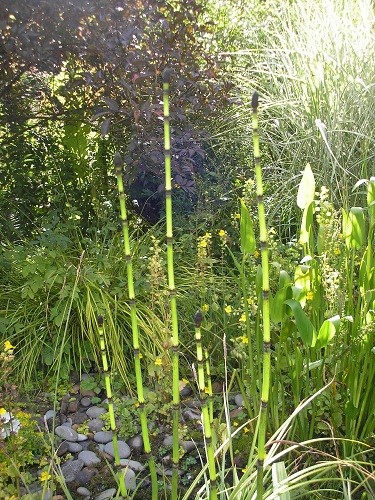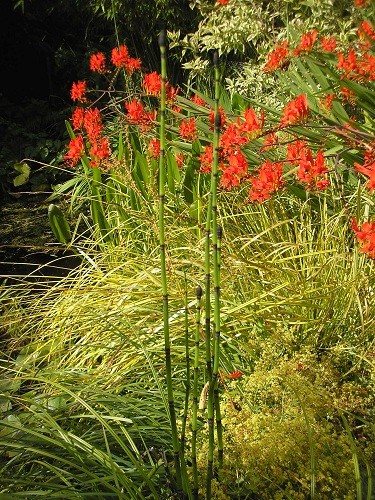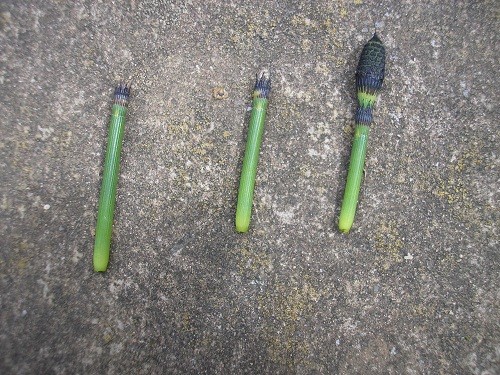Thought you might be interested in a really ancient plant that is here in the garden, in my pond. Not ancient because it was planted here 20 yrs ago when we came – but ancient because it was growing on this planet when the dinosaurs were wandering about. And they would have been wandering here, we are very near to the Jurassic Coast ! I am talking about Equisetum hyemale – and before you all throw your hands up in horror at having such an invasive plant in the garden, let me assure you that it is safely corralled in a pot !!
The reason I planted it was the result of hiring a coach and taking my woodcarving students to London in the late 1990s for an exhibition of woodcarvings by Grinling Gibbons, which had been gathered together from all round the world.
Grinling Gibbons 1648-1721, was the woodcarver to the court of Charles 11 through to George 1 and has work in St. Paul’s Cathedral, Windsor Castle ( we also saw the restoration work done after the dreadful fire ) Hampton Court and many other stately homes and palaces. The best examples that I have seen are at Petworth House in West Sussex.
When the experts examined the carvings with a magnifying glass, they found that the carvings were covered with very faint scratches as if he had used sandpaper to smooth them off.
The only problem was that sandpaper wasn’t invented for at least another 100 yrs !! Someone then remembered that 300 yrs ago, “scouring rush” was sold in the marketplace for scullery maids to use to clean their pots and pans, because of course there were no Brillo pads in those days. ( oh, to have a scullery maid !!! )
When they investigated further, they found that “scouring rush” was Equisetum hyemale and grew on the sand dunes in Holland, when it was then exported to London. By growing in sand, scilica was drawn up the stem with the water and then deposited on the inside of the stem. By splitting the stem vertically and turning it inside out, it can then be used as you would use sandpaper or a Brillo pad.
My plant obviously isn’t growing in sand and therefore doesn’t have the scilica deposited on the inside, but I used to take stems in for students to see when telling them the story. Now retired, so no more students – I think I will keep the plant though as it has such a fascinating history and has been around for so long. I will just have to make sure that it never escapes from its pot, my own little dinosaur sitting in the pond !
Watching a TV programme one evening, I think it was Springwatch, the presenter was talking about Equisetum hyemale and all of a sudden she pulled the stem apart where each dark line is and then put it back together again, in her words “just like Lego bricks “.
I can assure you that this photo was taken after I had separated each segment and put them together again, I then went back to the pond and restored it to the rest of its stem.
All this reminds me that Teasel, Dipsacus Fullonum, was the inspiration for Velcro, I wonder how many other inventions nature has inspired. Whatever we humans come up with – usually nature has got there first – she is absolutely wonderful !






this plant came with my garden, I don’t find it as invasive as the tough grass and it’s much prettier, I had heard it was used for souring pads but never knew before that it needed to be grown in sand and that it was the split stem, thanks, love the lego stems, Frances
I always remember seeing it in someones garden pond, there wasn’t much pond left, so I don’t want that to happen to mine, I agree that it is much prettier than grass and with such a history is well worth keeping.
Pauline – when I read this, I immediately had to rush out to the pond and try the “Lego brick” thing. I couldn’t believe it – it worked it went back together again! Amazing!
Thanks for such a fascinating post
K
I did exactly the same as you Karen, when the TV presenter did it ! And to think I cut a stem to take it to the class, I could have just pulled it and then put it back later !!
how fascinating – and it looks so attractive. I know about the velcro inspiration, but never heard about this before.
It’s amazing what nature comes up with to inspire us , there must be lots of plants out there Catmint, just waiting for us to discover their uses.